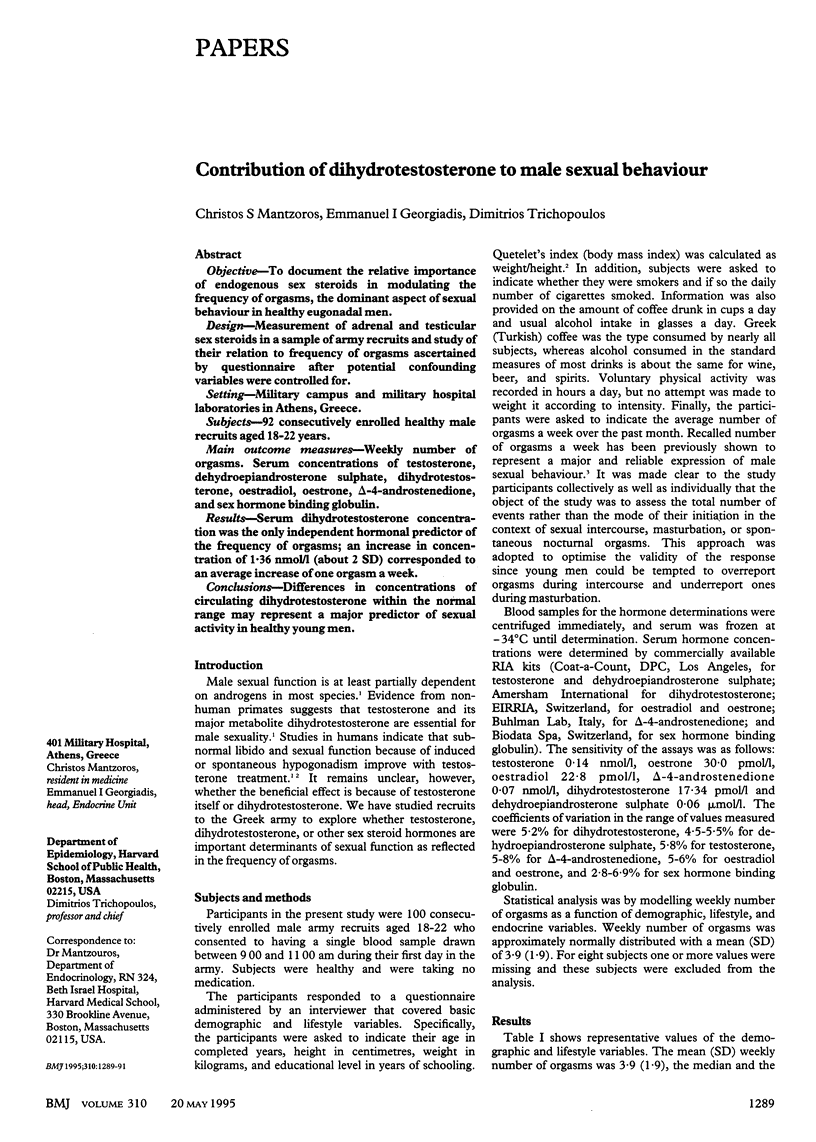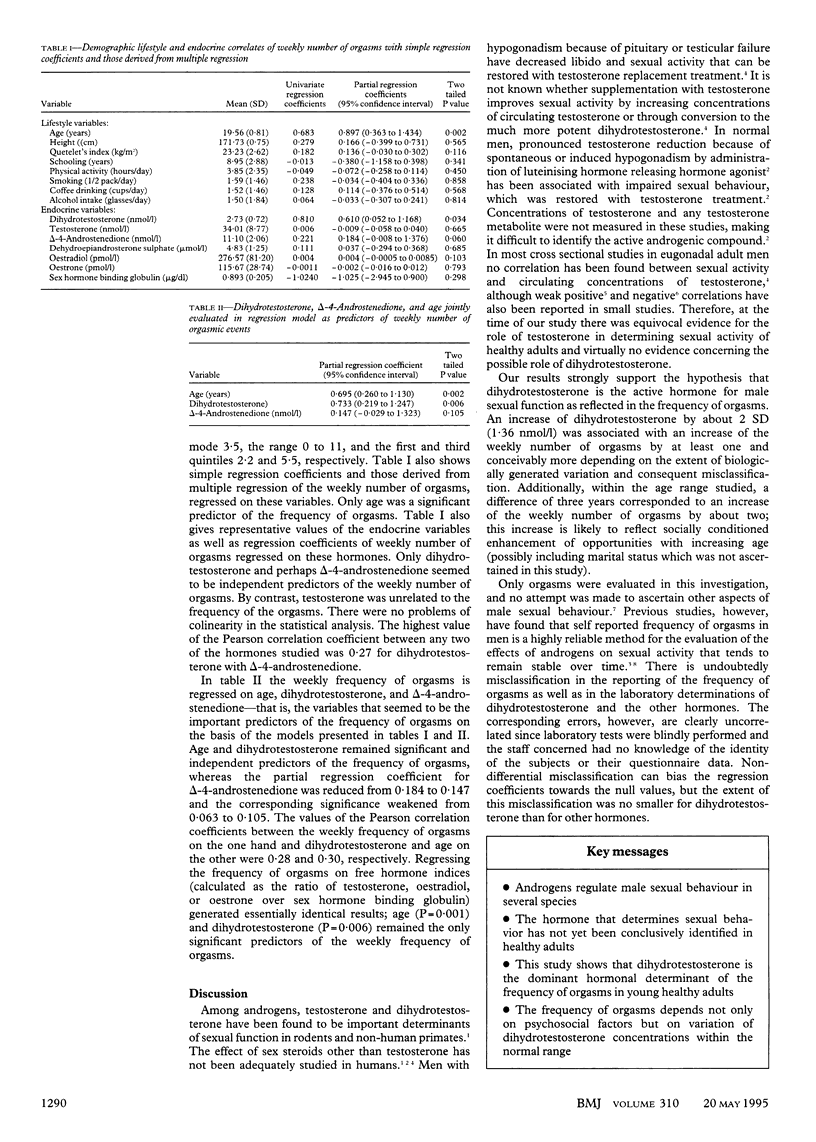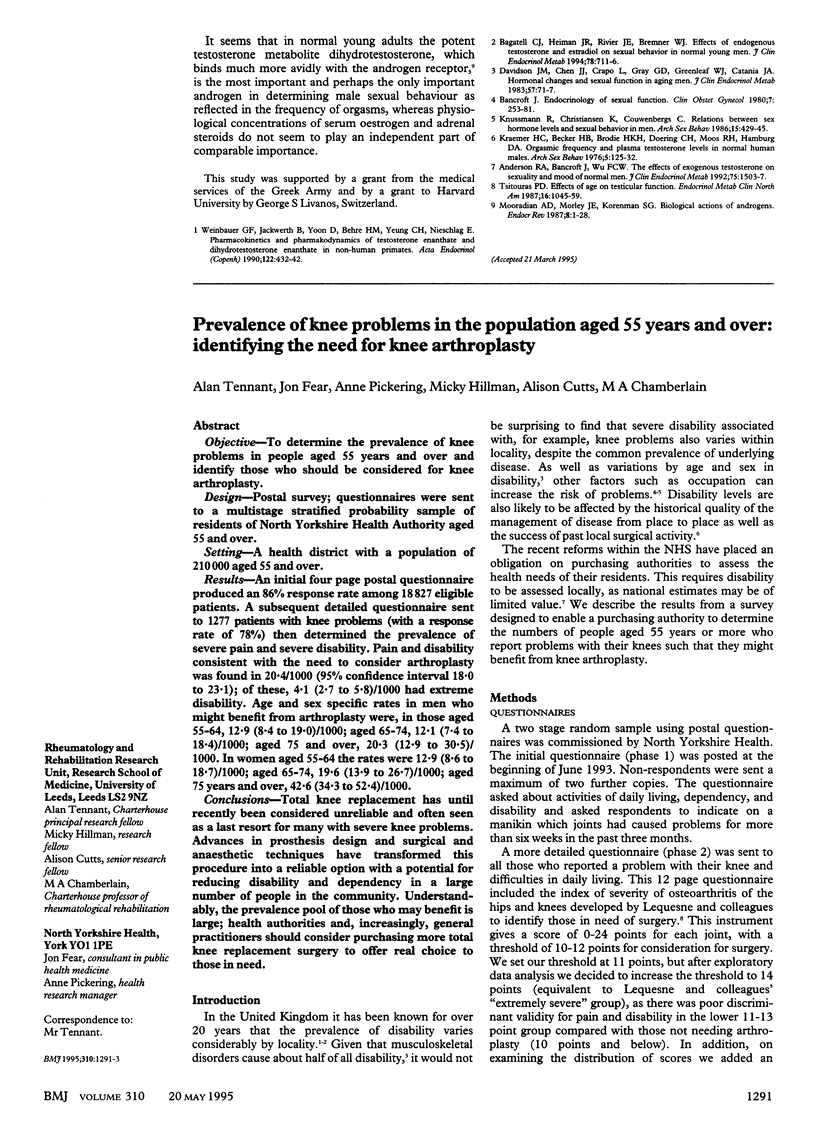Abstract
OBJECTIVE--To document the relative importance of endogenous sex steroids in modulating the frequency of orgasms, the dominant aspect of sexual behaviour in healthy eugonadal men. DESIGN--Measurement of adrenal and testicular sex steroids in a sample of army recruits and study of their relation to frequency of orgasms ascertained by questionnaire after potential confounding variables were controlled for. SETTING--Military campus and military hospital laboratories in Athens, Greece. SUBJECTS--92 consecutively enrolled healthy male recruits aged 18-22 years. MAIN OUTCOME MEASURES--Weekly number of orgasms. Serum concentrations of testosterone, dehydroepiandrosterone sulphate, dihydrotestosterone, oestradiol, oestrone, delta-4-androstenedione, and sex hormone binding globulin. RESULTS--Serum dihydrotestosterone concentration was the only independent hormonal predictor of the frequency of orgasms; an increase in concentration of 1.36 nmol/l (about 2 SD) corresponded to an average increase of one orgasm a week. CONCLUSIONS--Differences in concentrations of circulating dihydrotestosterone within the normal range may represent a major predictor of sexual activity in healthy young men.
Full text
PDF


Selected References
These references are in PubMed. This may not be the complete list of references from this article.
- Anderson R. A., Bancroft J., Wu F. C. The effects of exogenous testosterone on sexuality and mood of normal men. J Clin Endocrinol Metab. 1992 Dec;75(6):1503–1507. doi: 10.1210/jcem.75.6.1464655. [DOI] [PubMed] [Google Scholar]
- Bagatell C. J., Heiman J. R., Rivier J. E., Bremner W. J. Effects of endogenous testosterone and estradiol on sexual behavior in normal young men. J Clin Endocrinol Metab. 1994 Mar;78(3):711–716. doi: 10.1210/jcem.78.3.8126146. [DOI] [PubMed] [Google Scholar]
- Bancroft J. Endocrinology of sexual function. Clin Obstet Gynaecol. 1980 Aug;7(2):253–281. [PubMed] [Google Scholar]
- Davidson J. M., Chen J. J., Crapo L., Gray G. D., Greenleaf W. J., Catania J. A. Hormonal changes and sexual function in aging men. J Clin Endocrinol Metab. 1983 Jul;57(1):71–77. doi: 10.1210/jcem-57-1-71. [DOI] [PubMed] [Google Scholar]
- Knussmann R., Christiansen K., Couwenbergs C. Relations between sex hormone levels and sexual behavior in men. Arch Sex Behav. 1986 Oct;15(5):429–445. doi: 10.1007/BF01543113. [DOI] [PubMed] [Google Scholar]
- Kraemer H. C., Becker H. B., Brodie H. K., Doering C. H., Moos R. H., Hamburg D. A. Orgasmic frequency and plasma testosterone levels in normal human males. Arch Sex Behav. 1976 Mar;5(2):125–132. doi: 10.1007/BF01541869. [DOI] [PubMed] [Google Scholar]
- Mantzoros C. S., Georgiadis E. I., Trichopoulos D. Contribution of dihydrotestosterone to male sexual behaviour. BMJ. 1995 May 20;310(6990):1289–1291. doi: 10.1136/bmj.310.6990.1289. [DOI] [PMC free article] [PubMed] [Google Scholar]
- Mooradian A. D., Morley J. E., Korenman S. G. Biological actions of androgens. Endocr Rev. 1987 Feb;8(1):1–28. doi: 10.1210/edrv-8-1-1. [DOI] [PubMed] [Google Scholar]
- Tsitouras P. D. Effects of age on testicular function. Endocrinol Metab Clin North Am. 1987 Dec;16(4):1045–1059. [PubMed] [Google Scholar]
- Weinbauer G. F., Jackwerth B., Yoon Y. D., Behre H. M., Yeung C. H., Nieschlag E. Pharmacokinetics and pharmacodynamics of testosterone enanthate and dihydrotestosterone enanthate in non-human primates. Acta Endocrinol (Copenh) 1990 Apr;122(4):432–442. doi: 10.1530/acta.0.1220432. [DOI] [PubMed] [Google Scholar]


